The Allure of 2.0 Carat Engagement Rings Explained
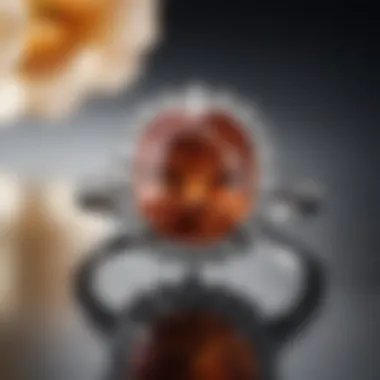
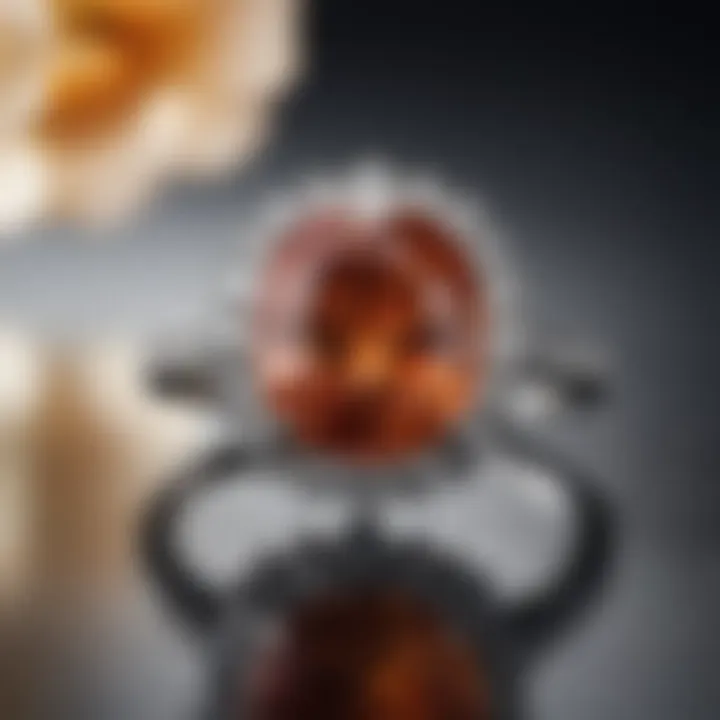
Intro
When it comes to symbolizing love and commitment, an engagement ring often takes center stage. Among the various sizes and styles, 2.0 carat engagement rings have emerged as particularly captivating. These rings strike a delicate balance between presence and sophistication, making them a popular choice for those looking to make a statement. However, the allure of a 2.0 carat ring goes beyond aesthetics. It intertwines with cultural significance, personal preference, and even ethical considerations.
Well, let’s dig a little deeper, shall we?
Gemstone Overview
Definition and characteristics
A 2.0 carat engagement ring usually shines brightest when set with a diamond, though many couples choose alternative gemstones like sapphires or emeralds. The carat weight refers to the weight of the gemstone, not its size. In many cases, a well-cut diamond of this weight can yield considerable sparkle.
A few characteristics to ponder:
- Cut: The way the diamond is shaped can determine how it reflects light. A well-cut diamond is essential for optimum brilliance.
- Color: Diamonds can range from colorless to various shades. A clear diamond is generally preferred, but hues can bring a unique charm.
- Clarity: This aspect refers to the internal and surface flaws of the stone. Fewer blemishes usually signify a higher quality.
Classification of gemstones
Gemstones can be categorized based on various factors—hardness, rarity, and origins among them. Diamonds are classified as precious stones, often considered the gold standard in engagement rings. In contrast, other gemstones, while magnificent in their own right, hold different value and significance.
Some popular categories include:
- Precious Stones: Diamonds, rubies, sapphires, and emeralds fall under this class due to their desirability and rarity.
- Semi-Precious Stones: This category encompasses a multitude of other gemstones that are less rare but no less stunning, such as amethyst, aquamarine, and topaz.
"A ring's value is not merely in its price tag but in its story, sentiment, and the journey it represents."
As you can see, choosing a ring involves a mosaic of choices shaped by taste, ethics, and sentiment. Moving ahead, we need to explore not just the aesthetic appeal but the intricate properties of these gemstones—factors that go hand in hand with the cultural significance of a 2.0 carat engagement ring.
Understanding Carat Weight
Carat weight is a crucial factor when it comes to selecting an engagement ring, especially one that shines at 2.0 carats. The weight of a diamond directly affects not just its size but also how it catches the eye, reflecting light in a way that captivates attention. When buyers understand carat weight, they can make more informed choices that align both with their aesthetic preferences and budget. This knowledge not only enhances the shopping experience but also ensures that the final piece feels true to the buyer's vision.
What is Carat Weight?
Carat weight is a measurement used specifically for gemstones, primarily diamonds, that indicates how heavy a stone is, and notably, one carat equals 0.2 grams. This terminology comes from the carob seeds that were historically used as a balance scale in trading gemstones. Each carat is subdivided into 100 points, making it easier to describe weights in finer increments. For instance, a diamond weighing 1.5 carats can also be referred to as a 150-point stone. However, it’s important to note that carat weight doesn’t directly equate to size; a well-cut diamond can appear larger than its carat weight due to its proportions and facets.
The Significance of Carat in Gemstone Value
In the realm of diamonds, carat weight bears considerable influence on value. Generally, as the carat weight increases, so does the price, due to the rarity of larger stones. However, the relationship isn’t linear; for example, a 2.0 carat diamond is often considerably more expensive than two 1.0 carat diamonds simply due to supply and demand dynamics.
When considering the significance of carat weight, one must also think about how it interacts with the other Cs—Cut, Color, and Clarity, which together craft a comprehensive view of the diamond's quality.
"A diamond is not just a simple stone; its value tells a story of its journey from the earth to your hand, wrapped in carats of beauty."
To summarize this point:
- Carat weight is crucial for determining the overall value and desirability of a diamond.
- Higher carat weights often come with a proportional price hike, making budgeting vital.
- An understanding of carat weight enhances decision-making when selecting a 2.0 carat engagement ring, combining personal taste with realistic valuation.
Grasping the concept of carat weight thus opens doors to a more informed and thoughtful jewelry purchasing experience.
The Aesthetic Appeal of 2. Carat Engagement Rings
When it comes to engagement rings, the aesthetic appeal holds significant weight in the decision-making process. A 2.0 carat engagement ring isn’t just a piece of jewelry; it encapsulates emotions, intentions, and cultural significance. This section explores how size, design, and customization play integral roles in creating an alluring piece that speaks to the individual's personality.
Visual Impact: Size and Sparkle
A 2.0 carat diamond is often seen as the sweet spot for many couples. It strikes a balance between statement and wearability. The sparkle of a well-cut diamond at this carat weight can turn heads instantly.
Its size can make it feel substantial on the hand, yet it remains manageable for everyday wear. The optical phenomena known as brilliance, dispersion, and scintillation are often heightened in stones of this size, leading to a breathtaking visual display that adds to its allure. In daylight or under soft candlelight, a quality stone will dance with light, captivating onlookers.
People tend to associate larger stones with more love and commitment, adding emotional layers to the overall appeal.
Choosing the Right Setting
The right ring setting can elevate a 2.0 carat diamond to new heights. It allows the wearer to express their style, whether they're aiming for vintage elegance or modern minimalism. The design will determine how the diamond interacts with light and how it blends with the wearer's other accessories.
Types of Settings
Prong, bezel, and halo— the types of settings available to showcase a 2.0 carat diamond are nearly endless. Each has its own unique characteristics. For example, a prong setting, with its minimalist design, allows maximum light to hit the diamond from all angles, enhancing its sparkle even further.
Conversely, a bezel setting encases the diamond, offering both protection and a sleek look.
While each type has its merits, the halo setting adds additional small diamonds around the central stone, creating the illusion of an even larger, more brilliant piece. This feature makes it a popular choice among couples who wish to amplify the ring's flash.
Metal Options
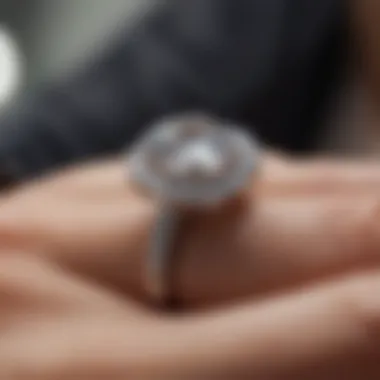
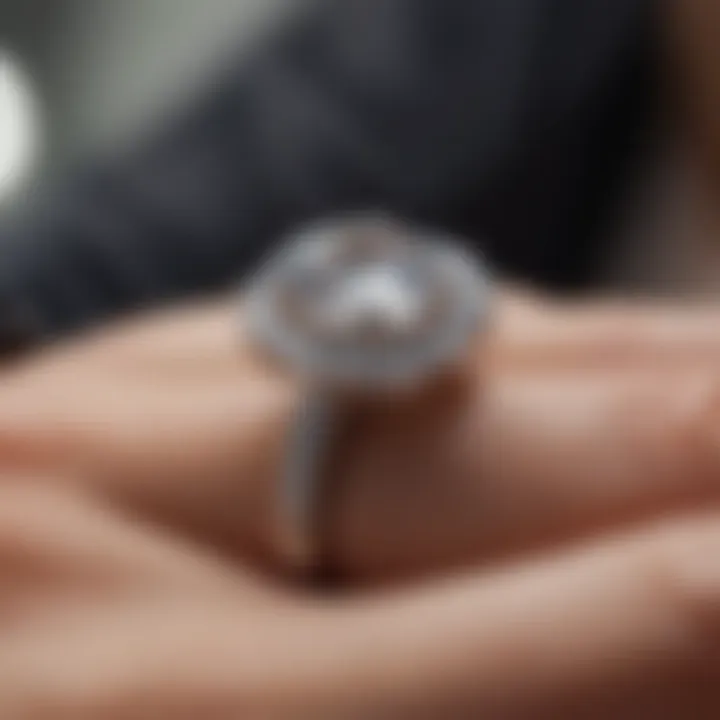
Another fundamental aspect of the setting is the metal used, each contributing differently to the overall aesthetic.
- Platinum offers a timeless and luxurious feel, ideal for those looking to invest in something enduring.
- White gold is a wonderfully popular choice, bringing a modern touch at a lower cost than platinum.
- Rose gold is currently in vogue, providing warmth and a romantic essence that is increasingly appealing to the contemporary buyer.
Choosing the right metal doesn't just alter the ring's appearance; it can affect durability and maintenance as well. For example, platinum, being more durable, is less likely to scratch, while gold may require more regular polishing to maintain its aesthetic. All these factors contribute to the allure of the 2.0 carat ring, marrying the stone's size with a setting and metal that reflect personal taste and lifestyle.
Evaluating Quality: The Four Cs of Diamonds
When it comes to understanding the allure of 2.0 carat engagement rings, the concept of quality is pivotal. The Four Cs—Cut, Color, Clarity, and Carat weight—serve as the cornerstone for assessing a diamond's overall value and visual appeal. For anyone looking to select the perfect engagement ring, grasping the Four Cs is not just beneficial; it's essential.
Cut: The Heart of a Diamond
The cut of a diamond is arguably the most critical factor of the Four Cs. This is where artistry meets science. It affects how light interacts with the diamond, something called brilliance. If the cut isn’t executed well, even a high-color and clarity diamond may appear lackluster.
"Cut is about proportion and symmetry. A well-cut diamond reflects light beautifully, enhancing its overall sparkle."
In fact, diamonds come in various shapes—round, princess, oval, and many more. Each shape has unique characteristics that influence its brilliance and fire. A round brilliant cut is often favored for its ability to optimally reflect light, making it a top choice among many buyers.
Color and Clarity: Assessing Beauty
Next up is color, which ranges from colorless to shades of yellow or brown. For a diamond, the less color it has, the higher its value. Usually, color grades are measured on a scale from D (colorless) to Z (light yellow or brown). A 2.0 carat diamond that is graded G or H often provides an excellent balance between appearance and price.
Then comes clarity, which measures the presence of inclusions or blemishes. Clarity can be rated from Flawless (no imperfections visible under 10x magnification) to Included (inclusons visible to the naked eye). A high-clarity diamond will sparkle more alluringly since there are fewer barriers to the light.
Carat Weight: Balancing Size and Quality
Carat weight is the final piece of the puzzle in understanding diamond quality. Although a 2.0 carat diamond is certainly impressive, it’s crucial to balance carat weight with the other Cs. Sometimes, going slightly smaller can lead to a higher grade in cut, color, or clarity, offering better overall value.
The perception of size can also be influenced by the diamond's setting. For instance, a well-designed halo setting can make a 2.0 carat diamond appear much larger, enhancing its visual impact without necessarily spending more.
In summary, the Four Cs collectively create a tapestry of quality, ensuring each diamond tells its own story. By weighing these factors carefully, potential buyers not only gain a thorough understanding of what they are purchasing, but they also learn to appreciate the unique qualities that a 2.0 carat engagement ring can offer.
Cultural Significance of Engagement Rings
Engagement rings have long been more than just ornamental pieces; they are steeped in meaning and emotional weight. Their significance goes beyond the sparkle and cut of the stone; it encompasses historical contexts, personal stories, and societal trends. In the realm of 2.0 carat engagement rings, this allure is amplified. The choice of a 2.0 carat ring is often seen as a symbol of not just love, but also commitment and partnership.
Historical Context of Engagement Rings
The tradition of giving engagement rings can be traced back centuries, evolving through various cultures and time periods. For instance, ancient Egyptians believed circular rings symbolized eternity, and they exchanged reed or hemp bands. Jump ahead to the Roman Empire, where rings became a public declaration of a man's commitment, often made from iron or gold. What stands out in the historical context is the symbolism attached to these rings. Back then, the ring served not just as a pledge of fidelity but also as a public commitment of ownership.
In many cultures, specific gemstones carried their weight in meaning. Diamonds, for example, became particularly popular in the 19th century, largely due to the discovery of diamond mines in South Africa and the marketing efforts of De Beers. The famous slogan "A diamond is forever" reinforced the idea that an engagement ring, especially one 2.0 carats or larger, should last a lifetime, reflecting the enduring nature of love.
Modern Trends and Symbolism
Today, 2.0 carat engagement rings serve as a powerful symbol in contemporary culture—representing love, status, and countless personal narratives. The modern buyer sees these rings as not just a piece of jewelry but as a milestone in life. Each ring, especially those with significant carat sizes, speaks volumes about personal success and the value one places on relationships.
The symbolism has also become multifaceted due to changing societal norms. For example, as more couples lean towards equality and partnership in relationships, the meaning of the engagement ring has begun to shift. It’s becoming common for both partners to select rings that hold equal value in terms of carat weight and cost.
"A 2.0 carat ring speaks not just of beauty, but of the journey and commitment shared between partners."
In the realm of modern trends, we also see a rise in customization, with couples opting for unique cuts or colored gemstones that resonate with their personal stories. Rings are now being crafted to reflect the individual style and values of the wearer—be it through vintage designs or contemporary artistry. This signifies a deeper understanding of what love and commitment represent today, beyond the monetary worth.
Ethical Sourcing of Gemstones
The conversation around ethical sourcing of gemstones has become increasingly pertinent in today's jewelry market. As consumers become more conscious about the origins of their purchases, the demand for rings that align with personal values has surged. This section serves to explore the significance of ethical sourcing within the realm of 2.0 carat engagement rings, emphasizing not only the moral implications but also how it enhances the overall value of the piece.
Understanding Ethical Considerations
Ethical sourcing goes beyond simply adhering to regulations; it embodies a commitment to responsibility and integrity in the trade. When one thinks about purchasing a 2.0 carat engagement ring, the weight of the stone's origin can have emotional implications tied to its value. This means understanding the labor practices, environmental impact, and community effects surrounding gemstone extraction.
Using gemstones that were sourced ethically ensures that miners and their communities benefit from the trade, creating a ripple effect of positive impacts. It's about making choices that reflect one's values, offering confidence that the purchase supports equitable practices.
Certifications and Standards
When navigating through the sea of gemstones, certifications can shine a light on ethical sourcing. Not all gemstones are created equal when it comes to their journeys from mines to markets.
Conflict-Free Diamonds
Conflict-free diamonds are at the forefront of ethical sourcing. These stones come from suppliers that adhere to international agreements like the Kimberley Process, created to prevent the trade of diamonds that fund violence or human rights abuses. Their key characteristic lies in the confirmed traceability of their origins, ensuring that buyers can feel secure about the ethicality of their investment.
The benefits of purchasing conflict-free diamonds include:
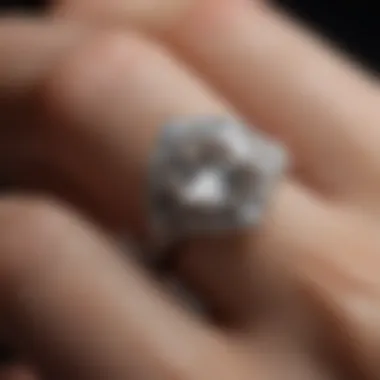

- Transparency: Consumers get detailed information about where their diamonds come from.
- Informed Choices: Awareness empowers buyers to make decisions that resonate with their personal beliefs.
- Support for Communities: Purchasing conflict-free diamonds often contributes to community development in mining regions.
However, it’s essential to recognize that while conflict-free diamonds highlight a conscientious choice, the system is not without flaws.
Lab-Grown Alternatives
Lab-grown diamonds represent a modern solution to ethical concerns in the diamond industry. These gems possess the same physical, chemical, and optical properties as natural diamonds but are created in controlled environments. The key characteristic of lab-grown alternatives lies in their reduced environmental impact and the absence of human rights concerns typically associated with mining.
Why are lab-grown alternatives attractive choices for buyers of 2.0 carat rings?
- Cost-Effectiveness: Usually priced lower than mined diamonds, making them accessible without sacrificing quality.
- Sustainability: The lower environmental footprint appeals to eco-conscious consumers.
- Customization Options: Produced in laboratories, they can often be crafted to meet specific desires with ease.
However, potential disadvantages may arise concerning long-term value and market perception, as the resale value of lab-grown diamonds can still be lower compared to natural ones.
In summary, exploring the ethical dimensions surrounding 2.0 carat engagement rings turns the spotlight onto responsible choices that resonate with buyers’ values. The trend towards transparent sourcing, whether through conflict-free diamonds or lab-grown alternatives, reflects a shift in consumer attitudes, providing a harmonious blend of beauty and moral integrity.
The Investment Perspective
When it comes to purchasing a 2.0 carat engagement ring, one cannot ignore the investment angle. While the emotional value is paramount, many prospective buyers also view such rings through the lens of financial return. This perspective opens up discussions about value retention and resale potential, steering the decision-making process beyond mere aesthetics. Recognizing the investment potential of these rings can lead to a more informed and satisfactory purchase, aligning choices with both personal sentiment and financial sensibility.
Value Retention of 2. Carat Rings
One of the significant benefits of opting for a 2.0 carat engagement ring lies in its potential for value retention. Unlike smaller carat sizes, which may depreciate more swiftly, a 2.0 carat diamond often holds its worth exceptionally well over time. The larger stone can serve as a strong asset, appealing to both sentimental and financial considerations. Buyers should be aware, however, that this retention is not merely a result of size.
Contributing factors include:
- Quality of the diamond: A well-cut, high clarity, and color graded stone tend to maintain higher market values.
- Branding: Rings from reputable jewelers can command premium prices in the resale market.
- Market demand: The popularity of certain styles or specific stones can fluctuate, impacting value.
Overall, a 2.0 carat ring stands as a bridge between beauty and sound investment, making it appealing to various buyers, from enthusiasts to collectors.
Factors Influencing Resale Value
While the allure of a 2.0 carat ring is evident, understanding the resale market becomes crucial for prospective owners. A number of elements play into the resale value, affecting how much one might recoup after parting with their beloved piece.
- Condition: A ring that’s well-maintained and shows no signs of wear will obviously fetch a better price. Regular cleaning and care can enhance its appeal.
- Market Trends: Jewelry trends, including cuts, styles, and even metal types, can shift over time. Keeping an eye on the current market can inform when to sell or hold onto the ring.
- Documentation: Having certificates from grading organizations like the GIA can significantly boost resale value. Buyers are more inclined to invest in a ring with verified quality.
"A diamond with a good story is often worth more than one without any history."
- Historical and Cultural Context: Rings with unique stories or notable backgrounds might appeal to niche markets, enhancing their value.
Ultimately, understanding these factors allows potential buyers to make wise decisions not just in purchasing, but also in considering how and when to sell in the future.
Choosing the Perfect 2. Carat Ring
Finding the ideal engagement ring can feel like searching for a needle in a haystack. With so many options, taking time to reflect on personal preferences and style is key. Engagement rings, especially those weighing 2.0 carats, play a significant role in symbolizing commitment and love. A ring that resonates with one's style not only shines brighter but also feels more personal.
Choosing a 2.0 carat ring requires careful consideration of several factors. For instance, the ring should reflect individuality and suit the wearer's lifestyle. While some may prefer classic designs, others might lean toward unique or modern styles. Ultimately, the choice should align with the couple’s shared vision of their future together.
Personal Preferences and Style
Style speaks volumes when it comes to an engagement ring. A 2.0 carat diamond ring can amplify one's personal aesthetic. Whether you lean towards vintage charm or contemporary flair, knowing what vibe you're aiming for can streamline the decision-making process.
Keeping a few key elements in mind can greatly assist:
- Shape of the Diamond: The cut can determine the overall look. Round, princess, or oval each has its own persona.
- Setting: The way the diamond is showcased can elevate its presence. Consider settings like solitaire for classic simplicity or halo for added brilliance.
- Metal Choice: Gold, platinum, or even rose gold can complement the stone’s sparkle and align with personal taste.
Budget and Financing Options
Navigating the costs of a 2.0 carat engagement ring can often be daunting, but understanding numerous budgeting techniques can make it manageable. Clear financial planning ensures that couples don’t stretch their finances too thin, allowing them to enjoy their new commitment without the burden of debt.
Saving Strategies
One effective approach to managing the budget for a ring is to adopt strategic saving habits. Setting aside a small amount each month can make a significant impact over time. Many couples find this choice appealing because:
- It encourages a sense of teamwork.
- Establishes a savings goal, making purchasing the ring feel rewarding.
- Reduces financial stress when it’s time to buy.
While some may feel impatient, it’s often worth it to save rather than jump into expensive financing options.
Financing Plans
Alternatives exist for those who might find saving too slow. Financing plans offer the ability to purchase a 2.0 carat ring without paying the full price upfront. This option is increasingly popular because:
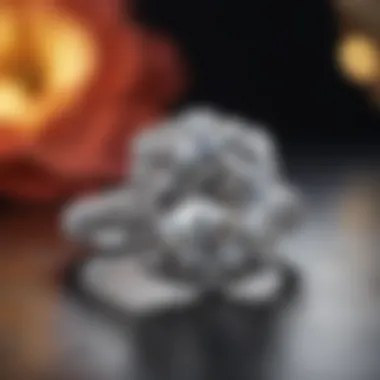
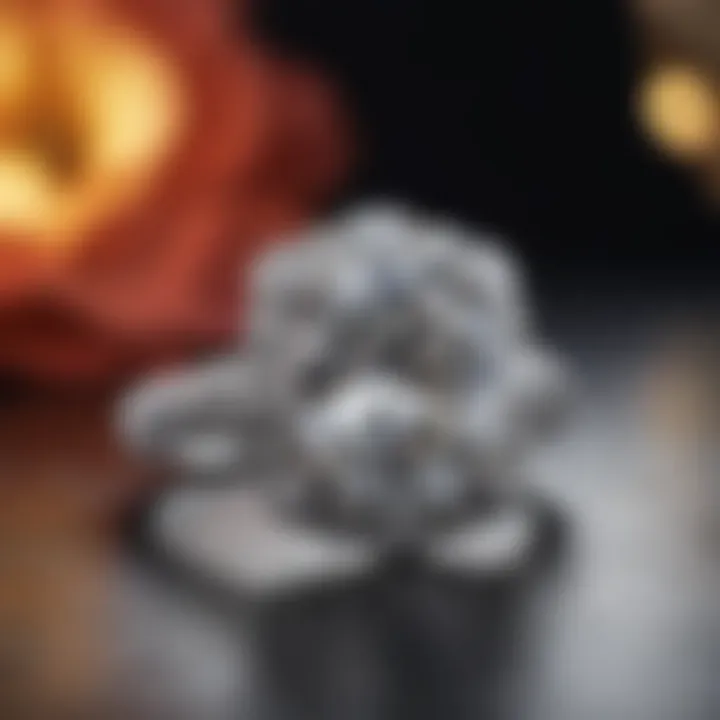
- It allows for immediate enjoyment of the ring while breaking down payments over time.
- Various financing options often come with low interest rates, making it an affordable choice in the long run.
- Some jewelers offer flexible terms catering to different budgets, making luxury accessible.
On the flip side, one must remain wary of potential pitfalls. Financing too much can create a financial burden if not managed properly, so it's essential to maintain control over one's spending habits. Understanding the full terms before signing is crucial.
In summary, the journey to selecting a perfect 2.0 carat engagement ring is not just about the stone, but also about embracing personal style and strategizing financially. Making thoughtful choices today can narrate a beautiful love story tomorrow.
Maintaining and Caring for Your Engagement Ring
Caring for a 2.0 carat engagement ring is not just about keeping it clean; it’s about preserving a symbol of love and commitment that holds significant emotional and financial value. Knowing how to maintain and care for this prized possession is essential for any gemstone enthusiast or lover. Proper care not only extends the life of the ring but also helps maintain its sparkle and beauty. Here we detail two crucial aspects: routine cleaning and professional inspections.
Routine Cleaning Techniques
Regular cleaning of a 2.0 carat engagement ring is vital. Dust, dirt, and oils from your skin can accumulate, dulling the shine of the diamond and affecting overall clarity. For routine cleaning, consider the following techniques:
- Mild Soap Solution: Mix a few drops of dish soap in warm water. Soak the ring for about 20 to 30 minutes, then gently scrub with a soft-bristle toothbrush, particularly around the prongs and beneath the stone. Rinse under lukewarm water and dry with a lint-free cloth.
- Ultrasonic Cleaners: If you want that extra sparkle, an ultrasonic cleaner can be quite effective. Just be sure to check whether your diamond is secure in its setting. Some settings, like halo or pave, may require extra caution.
- Avoid Harsh Chemicals: It’s best to stay clear of ammonia-based cleaners or bleach as they can cause damage to the metal and degrade the gemstone.
Keep in mind that consistency is key. Establish a routine cleaning schedule for your ring to keep it looking radiant. About every two weeks is a generally good practice, but if your lifestyle involves heavy manual work or exposure to chemicals, consider cleaning it more often.
Professional Care and Inspections
While cleaning at home is important, having a professional inspection is equally essential for the long-term care of your engagement ring. Schedule a check-up at least once a year. During these inspections, a jeweler can assess several key points:
- Loose Stones: Over time, prongs can wear down or loosen due to daily wear. A professional can tighten them to ensure your diamond remains secure, preventing potential loss.
- Setting Integrity: The overall condition of the setting can affect the durability of the ring. Jewelers look for signs of wear and make necessary repairs to keep the ring in pristine condition.
- Polishing: Professional polishing can remove scratches and restore a brilliant shine. While it’s tempting to do this at home, professionals utilize tools that achieve a level of polish that’s hard to match otherwise.
Tip: Always ask for a maintenance plan, which can make future visits smoother and ensure your ring gets the attention it needs.
"Caring for a 2.0 carat engagement ring is an ongoing commitment, reflecting the love it represents. Regular maintenance and professional care ensure the ring remains as stunning as the day it was given."
Popular Trends: Styles in 2. Carat Engagement Rings
The realm of engagement rings is ever-evolving, with popular trends often reflecting broader societal values and personal tastes. When it comes to 2.0 carat engagement rings, one cannot ignore how these rings have become symbols of both love and status. The choice of style holds significant weight, not just for aesthetic appeal but for how a couple’s unique story can be captured in the selection.
Vintage vs Modern Designs
Both vintage and modern designs carry an allure of their own, which can evoke different emotions and convey distinct messages. Vintage rings, often rich in history, resonate with those who appreciate craftsmanship from bygone eras. They often feature intricate detailing and unique shapes that tell stories of their own. Conversely, modern designs prioritize clean lines and contemporary elegance, catering to those who prefer a minimalist aesthetic.
Choosing between these two can often come down to personal preference, but one clear takeaway is this: each style has its set of devoted enthusiasts. Vintage rings, with their elaborate settings and ornate finishes, often appeal to those who want something that stands out with character. Modern designs, on the other hand, attract those who favor a sleek, sophisticated look that feels relevant to today's trends.
Unique Cuts and Shapes
Beyond traditional preferences, the cuts and shapes of gemstones play an essential role in defining the personality of a ring. Each cut holds its charm and can dramatically affect the appearance of the diamond, catering to different tastes and styles.
Round vs Princess
The round cut is perhaps the most well-known and widely favored shape. Its brilliance and ability to reflect light make it an ideal choice for many. The reason behind its popularity lies in its timeless appeal and versatility. The round cut can fit well in nearly any setting, be it vintage or contemporary. In contrast, the princess cut boasts a more modern edge with its square shape and sharp facets. This cut captures light differently, producing a unique sparkle that can be captivating as well.
Choosing between round and princess can often depend on the wearer’s style. The round cut provides a classic elegance while the princess cut often evokes a bold, confident look. Both have their unique features – the round cut excels in brilliance, while the princess cut tends to exhibit a more pronounced shape.
Emerald vs Oval
Emerald and oval cuts present two paths for those seeking distinctiveness in style. The emerald cut is known for its step cuts and large facets, giving an allure of sophistication and vintage charm. Its elongated shape creates a captivating optical illusion, enhancing the perceived size of the stone, which creates an air of grace. On the other hand, oval cuts merge the traits of round and marquise cuts, offering a unique shape that exudes elegance. The oval cut can make fingers appear longer, a subtle but significant detail that many find appealing.
In summary, when diving into the details of unique cuts and shapes, one can appreciate how each option—be it round, princess, emerald, or oval—holds attributes that resonate with various audiences. These styles reflect not only personal tastes but also the cultural significance of engagement rings in their current context.
Embracing the popular trends in 2.0 carat engagement rings offers an opportunity for expressing individual personality while also adhering to the romantic history they represent.
Real-Life Testimonials and Experiences
When it comes to the allure of 2.0 carat engagement rings, real-life testimonials provide a personal touch, giving potential buyers insight into others’ journeys. These stories aren’t merely anecdotes; they act as a bridge connecting the past decisions with present aspirations. As many individuals embark on the quest for the perfect ring, hearing about others’ experiences can alleviate some of the pressures associated with such a monumental purchase.
Buying Experiences of 2. Carat Rings
One common theme that emerges from testimonials is the diversity in buying experiences. For many, the hunt for the ideal 2.0 carat ring is not just a shopping venture but a deeply emotional journey. Some recount spending weekends together to browse local jewelers, noting how different settings and styles evoked varying feelings. The glow of a diamond when placed under natural sunlight, contrasting with its less shining appearance indoors, often surprises buyers.
Moreover, buyers frequently emphasize the importance of education during their purchasing experience. For example, one buyer might mention how studying the Four Cs—cut, color, clarity, and carat—informed their decision drastically, leading them to prefer a well-cut diamond despite it not being the largest.
“I learned that the cut really makes a difference in how a diamond sparkles,” says Sarah, reflecting on her choice.
As these narratives unfold, one can see how communication with knowledgeable jewelers shapes the buying process. Sometimes, buyers even opt for custom designs, cherishing the input they can contribute to the ring’s artistic elements.
Emotional Connections to Gemstones
In these stories, the emotional connections people form with their gemstones are truly inspiring. A ring is often perceived as more than just a piece of jewelry; it becomes a vessel of memories, dreams, and promises. For many, the moment they first laid eyes on that stone—often accompanied by a heartfelt proposal—remains vivid in their minds.
People describe how the 2.0 carat engagement ring symbolizes milestones in their relationship. For Lisa, her engagement came as a surprise during a family gathering, and the ring’s sparkle during the proposal moment crystallized her emotions forever.
"Every time I look at my ring, I remember that night—the laughter, the tears, the joy. It’s not just a diamond; it’s our story,” she shares.
These emotional ties to the gemstone significantly influence how some individuals perceive the ring throughout their lives. Over the years, couples may find themselves revisiting these memories, reinforcing their bond.



